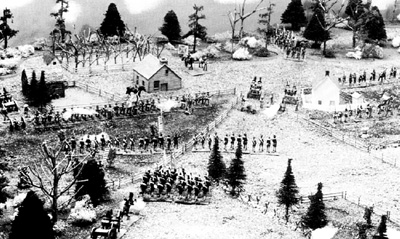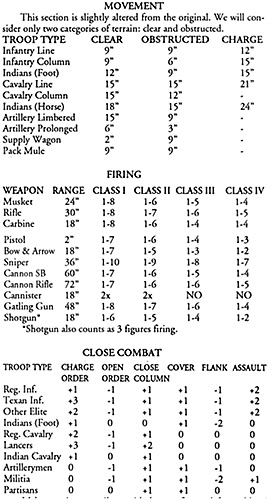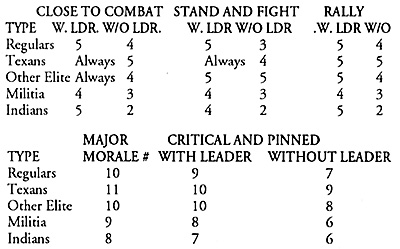 Inspired by the recent release of the 40mm range of ACW figures by
Wargames Foundry, and the discovery that Jack Scruby's 40mm figures
are still being produced, I decided to have a go at some large scale
skirmishing in the ACW period. Being a big fan of 54mm wargames, one
of the few drawbacks has always been the limitations in the numbers of
figures that could be deployed on a standard Ping Pong table layout. In
40mm figures, the answer has been found. Having all of the detail of the
54mm figures, but being about 1.5" tall, they strike the perfect balance.
Big enough to be real collector's pieces, but small enough for a fairly large game to be set up.
Inspired by the recent release of the 40mm range of ACW figures by
Wargames Foundry, and the discovery that Jack Scruby's 40mm figures
are still being produced, I decided to have a go at some large scale
skirmishing in the ACW period. Being a big fan of 54mm wargames, one
of the few drawbacks has always been the limitations in the numbers of
figures that could be deployed on a standard Ping Pong table layout. In
40mm figures, the answer has been found. Having all of the detail of the
54mm figures, but being about 1.5" tall, they strike the perfect balance.
Big enough to be real collector's pieces, but small enough for a fairly large game to be set up.
CIVIL WAR ACTION. Photo by Orv Banasik, figures from his collection
I gave serious thought to the type of rules I wanted to use, as well as the type of game that I wanted. In the end, I opted for a variation of my all-time favorite rules, The Sword and the Flame. Since the rules really are designed for a sort of mega- skirmish, they seemed ideal for the sort of game I had in mind. So, sitting down for a couple of days with references and the rules, the pages that follow are the results of my labor. As you will see, I have also included a couple of ideas from the world of Toy Soldier games, which fit the flavor of what I wanted. So, without further ado, and with my apologies to Larry Brom, I present to you Tall White Mansions and Little Shacks.
NOTE: The Sword and The Flame rules are requared to play and are available from Greenfield Hobby, 32660 Dequindre, Warren MI 11354.
INTRODUCTION
The rules that follow have been adapted from Larry Brom's Rules Kit, The Sword and the Flame. The rules focus specifically on the American Civil War, but cover the period from John Brown's raid, to the end of the Nez Perce Wars. Basically, uniforms, weapons, and tactics remained fairly constant throughout the 22 year period.
The variations of the rules include, in this case, several ideas taken from the writings of H.G. Wells, and his contemporary disciple, Frank Perry, related to Little Wars with traditional toy soldiers. Other changes have been made to capture the feel of the civil war, though the basic mechanism of TSATF have not been altered.
Unit organization remains essentially the same, with the one optional addition of a flag bearer in each unit, in addition to the officer and NCO in the infantry unit, and the officer and bugler in the mounted unit. Specialized units, such as scouts and sharpshooters, may be used in 1/2- sized units of 9 or 10 infantry and an officer or NCO. Artillery will be slightly changed from the original. Borrowing an idea from H.G. Wells, we will say that an artillery piece must have a crew of four figures around at all times, or it may neither move nor fire. This is actually fairly realistic, as longer range and more accurate weapons made gunners popular targets for snipers. It may be wise, therefore, to keep a couple of extra figures around as part of the battery to replace fallen crew men. However, only the four figures actually manning the gun count when firing.
The rules will be played exclusively with 40mm figures from Jack Scruby and Wargames Foundry. All figures will be individually mounted.
Movement and firing sequence will be governed by the use of cards, though not ordinary playing cards in this case. Here we will use a single card for each unit in play, with that unit's name. Each side will also have a card for the Army Commander, that will allow an extra move for a unit chosen by the player. (The author's prejudice -- these play well with 25 mm figures -ED.)
So, fall in behind the major, and beware of too quiet railroad cars! Have fun!
 MOVEMENT
MOVEMENT
This section is slightly altered from the original. We will consider only two categories of terrain: clear and obstructed.
Obstructed terrain will basically cover everything from fences to urban rubble anything that impedes the free progress of troops. Note, it is assumed that troops in line will be in a relatively loose order, hence less concerned about dressed formations than troops in column. It is also assumed that troops in line will be in open order, unless actually closing up to charge or receive a charge.
Troops changing formation from line to column, mounted to dismounted, etc., will lose 1/3 of their move to do so. However, troops going from any position to prone or vice versa will require a full move.
Engineers or infantry laborers may be pressed to dig entrenchments instead of movement. A group equivalent to 1/2 of a unit may entrench a frontage of 15 " in 3 moves.
River crossing depends on the width of the river. A stream less than 3" wide may be crossed at any point. A river of between 3" and 9" may be crossed only at a marked ford or bridge. A river over 9" wide may only be crossed at a bridge. Troops backed up to a river who receive a failing morale result will surrender.
Units that have lost all cadre figures must roll at the start of each turn to see whether or not they may move. Rolling 1d6, all regular troops will stand on a roll of 5 or 6, and Indians and other irregulars on a 4-6.
Note that cavalry acting dismounted may only deploy 9 out of 13 figures, the rest being required as horseholders.
FIRING
All fire will be done by individual figures or weapon crews. Each figure manning a gun counts as 3 firing. Again, a gun must have a full crew in order to fire. Fire is conducted by rolling 1d20 (1 to 0, twice), for each figure firing, 3 for gun crew, 4 for gatling gun crew. Most regulars at this time will be armed with rifled muskets, hence using the rifle stats. Militia units will use the stats for muskets.
For each hit registered, draw a card from a standard deck of cards. Read the results as follows:
- Spade, Club= pinned, check morale
Diamond= wounded
Heart= killed
Troops who are wounded, pinned, shaken, or charging may not fire. Also no troops can fire into a melee.
Gatling Gun rolls to jam each turn, 2d6, jams on 11 or 12.
Hand grenades saw limited use during the Civil War, especially in trench fighting and sieges. Each grenade counts as 3 figures firing, and may be thrown up to 9". The thrower rolls 1d6 to see if it explodes. Read the die roll as follows:
- 1-3= fails to explode
4= explodes early, kills thrower
5-6= explodes on target, 3 hits!
Grenades should probably only be available to engineers, and even then, no more than 1d6 worth. If the grenadier is hit, he is killed instantly, and the exploding grenades hit anyone within 3" of him.
Note that snipers will be allowed to aim at specific targets.
"Key" Figures in this variant include the following:
- Artillery Crew
Sharpshooters
Grenadiers
Observers
Engineers
Cavalry in a mixed target
Rifle armed vs. melee
Flag Bearers
CLOSE COMBAT
Melees occur when 2 bodies of troops come into base to base contact based on the aggressive movement of one or the other. Taking another idea from H.G. Wells and Frank Perry, we will say that a unit wishing to charge must have at least 2/3 of its original strength before the straggler roll.
The charging unit rolls 1d6 for stragglers, those figures remaining at the unit's starting point, rejoining the unit if it wins the melee, or fleeing with it if it loses.
Each figure in combat rolls 16, the higher modified die roll winning. The actual impact on the loser depends on the actual die number rolled.
- Lose a melee rolling a 1 or 2 = killed
Lose a melee rolling a 3 or 4 = wounded
Lose a melee rolling a 5 or 6 = pushed back
The die rolls may be modified by the following factors:
Melee continues until one side has no figures left capable of fighting. Any stragglers or wounded figures may rejoin the fleeing forces. The victor occupies the ground held by the defender, and his stragglers now rejoin him.
Flags in this period still held an important place in a unit's pride and their morale. Anytime a Flag Bearer is involved in and loses a melee, roll a further d6 to decide the fate of the flag.
- 1 or 2: using the flag pole as a spear, the bearer manages to
hang onto it, even as he is driven back. If the result is a kill, this roll
indicates that he fell on the colors, and the enemy cannot get at him.
3 or 4: the flag was snatched out of his hands by his opponent, but quickly recaptured by his comrades in arms.
5 or 6: a black day for the unit, the enemy has made off with the colors!
The loss of the flag will lower the unit's morale numbers by 2 for the rest of the game. Conversely, capturing colors raises morale by 2.
Assault columns are used primarily against other regulars in close formations, or against entrenched positions. To look right, a column should be longer than it is wide. Open order troops may pass through a column without disrupting it if friends. Opposing skirmishers are simply pushed aside, they are not engaged by the column.
NOTE: Taking another tip from the old masters, we will introduce the following rule concerning built up areas. Troops may shelter on the roofs of flat-topped houses, or behind any house, but under no circumstances may they be placed within a structure, unless it has been hit by artillery fire and turned to an open enclosure.
 MORALE TESTS
MORALE TESTS
Troops are required to take morale checks when: charging or being charged, when pinned or shaken, and when losses in a unit reach 50%. To pass any of the test listed below, the player must roll equal to or less than the listed number (or the altered number if flags are won or lost).
Troops failing to close to combat fall back 6" facing the enemy, and become pinned.
Troops failing to stand a charge retreat 12" and become shaken.
Shaken troops may try to rally. However, if they fail, they continue to retreat until they pass or run off the table.
MAJOR, CRITICAL, AND PINNED MORAL (roll 2d6)
NOTE: THESE TESTS ARE TAKEN AT THE START OF THE TURN!
Troops check major morale when the overall force commander has been hit. Each unit checks. A failure means that the unit will not move in the turn.
Pinned morale is checked to recover troops who failed to charge. If they fail, they remain pinned until they pass.
Critical morale is check every turn after a unit reached 50% of its starting strength. Failure means that the unit is broken and beings to immediately rout at charge speed towards the nearest table edge. At the edge they may take one last test. If they fail there, they are then removed from play.
This completes the basic adaptation of TSATF. What will follow is a series of embellishments, in the spirit of the original, to more accurately capture the feel of the Civil War period.
AMPHIBIOUS OPERATIONS
The Civil War was, to a great extent, fought on and around the great rivers that run through the continental U.S. As such, both sides spent a great deal of time in planning and carrying out river warfare both in support of and exclusive of land forces.
Barges to carry troops, horses, etc., would generally be towed part of the distance by gunboats or other shallow draft powered vessels. They would then be poled or rowed in by their crews the last yards to the shore.
We will allow a barge moving under its own speed to move at a rate of 6" per turn. If it is being towed, it will move at the rate of the towing craft. A barge may carry a single basic unit of any type; i.e., infantry platoon, cavalry troop, or artillery section. The sailor crew of a barge will count as key figure targets, and the barge will be considered to be sinking if all the crew have been hit. All passengers would then be carded for as if hit by small arms fire.
Troops embarking or offloading lose 1/3 of their allotted movement.
TRAINS
Trains also played an important part in the war, and many actions centered around the possession of railway stations or junctions. For game purposes, we will standardize a train as consisting of 1 engine/coal car, 3 wagons, and a caboose. Each wagon may carry 1 basic unit. The caboose may carry force command of up to 4 figures. The train will have a crew of 4. It is considered a Class IV, key figure target. For each confirmed killing hit, the train will lose 3" of speed.
A train will move a maximum of 24" loaded or 36" empty. It must lower its speed by 12" increments when starting or stopping.
BALLOONS AND SCOUTING
While the size of the figures being used effectively scales down the area of battlefield being represented, it will still be possible for troops to be hidden from view. This will be especially true during Indian fighting games.
Hidden Indians may be spotted by regular troops at a distance of 6 " by rolling a 5 or 6 on 1d6.
Trained scouts increase the chances, spotting at 8" on a roll of 4- 6.
Regular troops in concealed positions may be spotted by other regulars at a distance of 6" on a roll of 4-6, and by trained scouts at 8" on a roll of 3-6.
Observation balloons, moving 18" per turn, will see any troops in place in an area 12" in diameter. Balloons will count as Class 111, key figure targets.
FIRE AGAINST BUILT-UP AREAS
Keeping in the spirit of these rules, fire directed against buildings will be handled in a fairly simple fashion. The class of a building will serve to indicate how many hits it can absorb before it is destroyed. Only killing hits will count against structures.
E.g., artillery firing at a field emplacement of revered earthworks will find that the target will need three hits to be destroyed. Once the total is reached, the target is rendered useless in the cause of entrenchments or rubble in the case of buildings or walls. The area destroyed is that within the cannon's cone of fire. Note that grenades can also be used in this fashion. Hits on these targets will be cumulative.
*For those of a different generation, the title is a line from the late 60s song, Southern Man, by Nell Young.
Back to Table of Contents -- Courier # 61
To Courier List of Issues
To MagWeb Master Magazine List
© Copyright 1993 by The Courier Publishing Company.
This article appears in MagWeb.com (Magazine Web) on the Internet World Wide Web.
Other articles from military history and related magazines are available at http://www.magweb.com